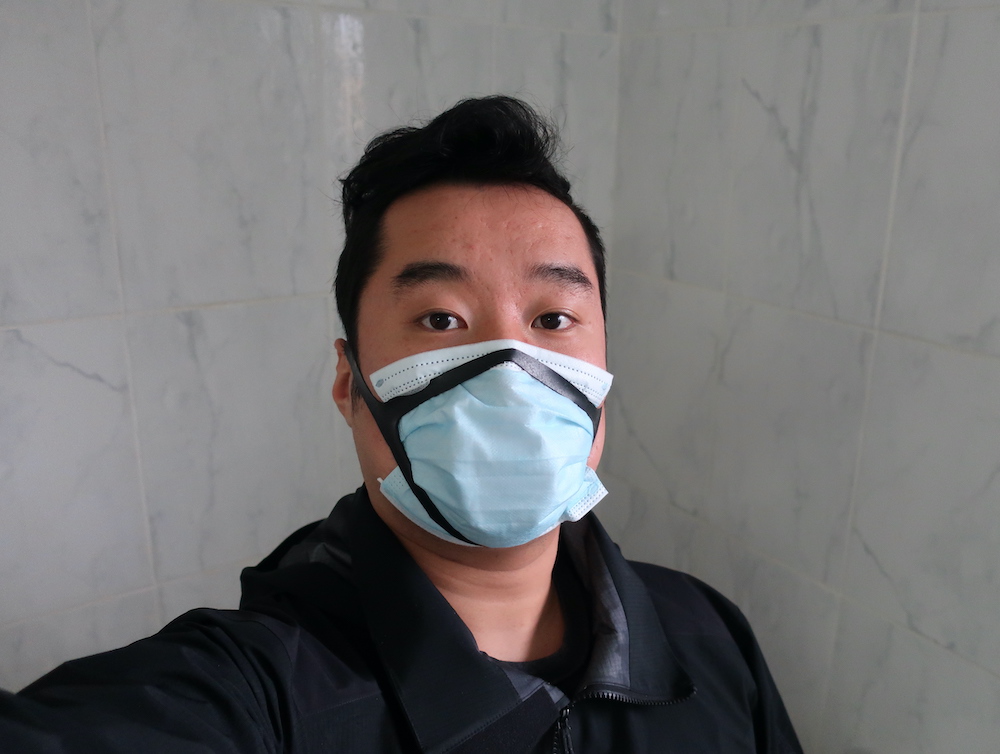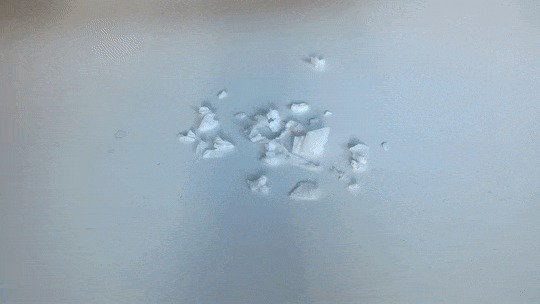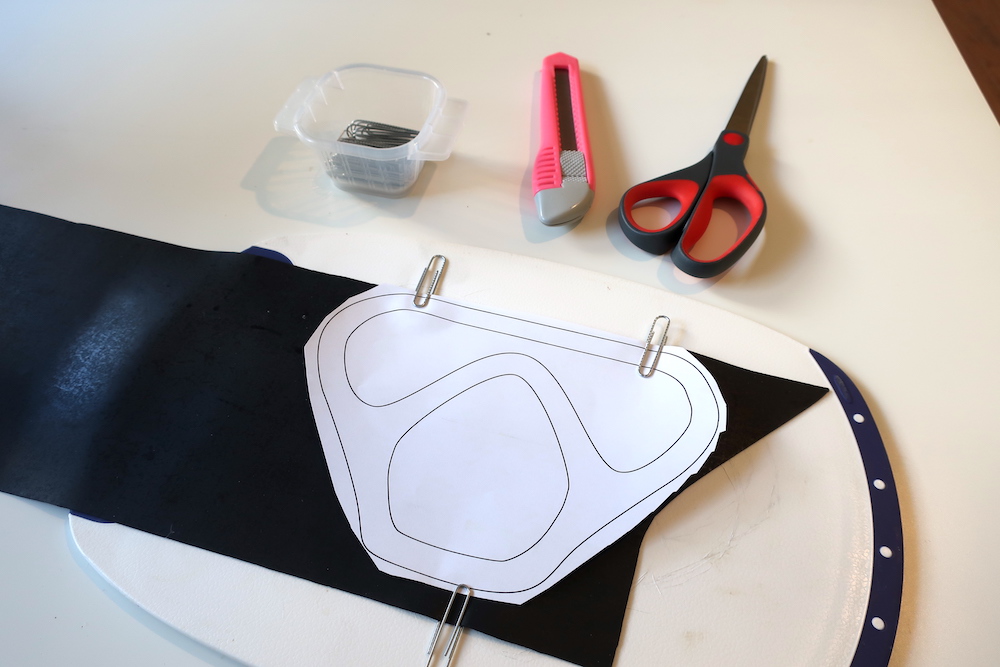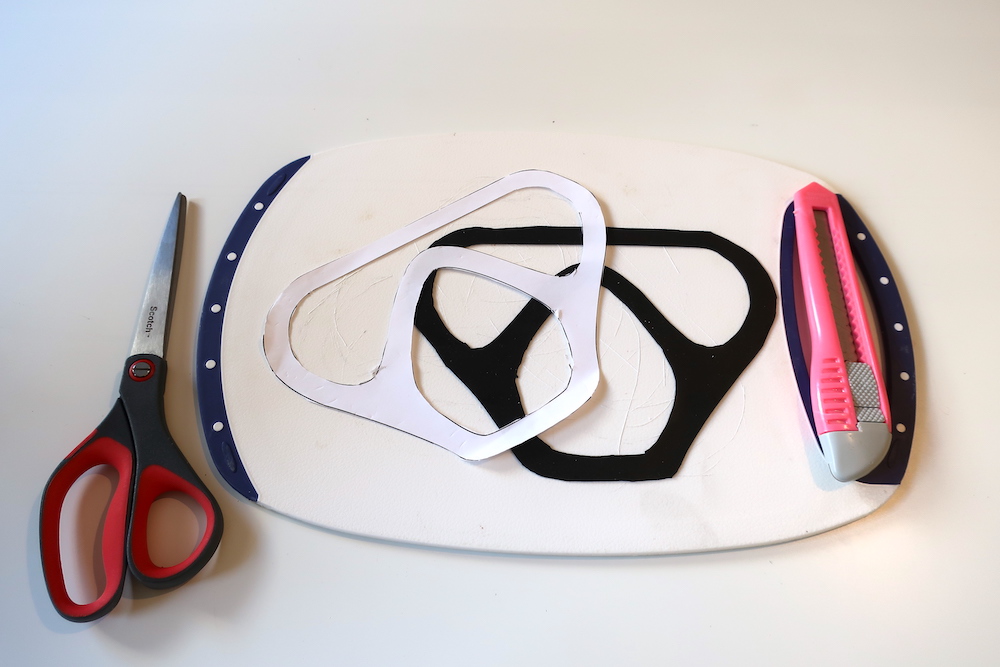I made an N95-level mask at home, and you can too
Cross-posted on my blog: https://billmei.net/blog/mask-brace
As a follow-up to Why don’t we tape surgical masks to the face to seal them airtight?, I discovered the answer is yes, this is likely a very good idea, only it’s much more convenient to use a rubber mask brace instead of tape. I summarize my research into this and provide convenient DIY instructions for you to do this too in this article. Here’s what the brace looks like:

It turns out that surgical masks are made of the exact same material as N95s! They both filter 95% of 0.1μm particles. The only reason N95s are “better” is because they create a tight seal around your face, whereas air leaks out of the sides and top of a surgical mask.
So if you could create a tight seal with a rubber brace (or some rubber bands), then theoretically a surgical mask could be equally as effective as an N95.
This has several benefits, the biggest being that surgical masks are way cheaper and easier to make than N95s. They’re highly available too, at least where I am here in Ontario. I got a box of 50 for CAD$9 at the grocery store. As a civilian you can’t purchase an N95 anywhere at any price.
There’s no peer reviewed data yet on whether surgical masks + brace are actually equally as effective as N95s, but the folks over at Fix The Mask are trying to conduct this research, which is where I first heard about this concept.
Unfortunately, the people behind Fix The Mask seem a bit sketchy to me for reasons that I defer to in this footnote.[1]
Anyway, are you still using a cloth mask? If so, I strongly encourage you to upgrade to a surgical mask and leave your cloth mask in the closet.
I unfortunately couldn’t find any solid data comparing the relative effectiveness of cloth vs. surgical vs. N95 masks, but based on the handful of studies I dug up I would estimate surgical masks to be 50% to 1000% more effective than a cloth mask, pushing the number up to the higher end if you additionally use a rubber brace to ensure a tight seal.
This ballpark aligns with the figures used by the folks at microCOVID, whose calculator models a 2x increase in effectiveness when upgrading from a “Cotton mask, bandana, or buff” to a “Surgical mask or mask with PM2.5 filter insert”, and a 10x increase when upgrading from cotton to a “Well-fitting, well-sealed N95 respirator”. Here is a link to their sources.
The main reason cloth appears to be less effective than surgical is that the “holes” between the plastic fibres in a surgical mask are 10x smaller than cloth threads, and are layered on top of each other so even if particles pass the first layer, they have many other layers to contend with. You can’t layer cloth or pull the threads tighter because that would make the mask unbreathable and uncomfortably hot.

The other major reason cloth masks fall short is they lack the electrostatic capture that melt-blown fabrics provide. This property means that even particles smaller than the holes between the fibres can get electrically attracted to and stuck against a surgical mask. Here’s my demonstration of how this works:

MinutePhysics has a video explaining the science behind the electrostatic effect: The Astounding Physics of N95 Masks. Conveniently, this is also a quick way to check if the surgical masks you purchased are counterfeited. Fake masks won’t attract particles like real masks do.
MacIntyre et al. appeared to find that cloth masks were worse than the “control group”, which contrary to clickbaity headlines from journalists who didn’t read the paper, this doesn’t mean that cloth masks are worse than no masks at all, since the control group was using “standard practice”, which involved a mixture of wearing medical (37%), cloth (8%), N95 (n=3), no mask (n=2), or a combination of masks (53%). “Standard practice was used as control because the IRB deemed it unethical to ask participants to not wear a mask.” What is conclusive however, is the study does show that cloth masks are worse than medical masks, by a factor of 1.5x − 11x depending on the type of particle.
Rengasamy et al. showed that unfitted surgical masks were equally (>99%) effective as N95s at filtering out virus particles at ∼3.0 µm size, even if they failed the standard NIOSH NaCl aerosol test used for the N95 certification.
Skaria and Smaldone concluded that “Airflow resistance across sealed surgical masks approached that of the N95”.
Shakya et al. concluded that “cloth masks are only marginally beneficial in protecting individuals from particles<2.5 μm. Compared with cloth masks, disposable surgical masks are more effective in reducing particulate exposure.”[2]
To be 100% clear, you should still wear your cloth mask if you lack other alternatives. In the Shakya et al. study, although cloth masks were “only” 15%-57% effective, compared to >95% for N95 masks, that’s still way better than not wearing a mask, which is 0% effective. Cloth is better than nothing and it was the correct public health recommendation back in March and April when we needed a quick reaction in the face of widespread PPE shortages, but we’ve had enough time now to catch up production, and you should upgrade your cloth mask to a surgical mask if they are cheap and available in your area. Importantly, these studies are talking only about the effectiveness of cloth masks at protecting you, but wearing a cloth mask is much more effective at protecting others.
Also be careful not to risk-compensate by taking more risky activities under the excuse of wearing a more effective mask; it’s still risky to throw an indoor birthday party no matter what mask you’re wearing.
If you don’t want to make the rubber brace for your surgical mask, you could consider donning a fitted cloth mask on top of your surgical mask to help reduce side leakage of air from wearing a surgical mask alone, as I know there are now cloth masks that are shaped for better fit on your face.
While surgical masks are not reusable compared to cloth masks (because they lose their electrostatic charge over time), fortunately they are cheap and widely available enough (at least in Ontario) that it’s not a big deal to just don a new one every time I leave the house. If they’re less available in your area you could consider reusing them a handful of times before throwing them out, by letting them air out on a hanger for a week between uses (but don’t expose them to sunlight or UV, which may melt the plastic or interfere with the electrostatic charge).
The rubber brace is certainly reusable. When removing it, I can just pull the head strap off and it falls away from me without my needing to touch the used mask, which I can easily dispose of and then reuse the brace by washing it with soapy water.
Even better, because the rubber brace holds the mask securely on my face and goes around the back of my head, I can cut off the loops that used to go around my ears to avoid straining my ears. You can see this if you look closely at my selfie above.
How to make your own mask brace
Step 1. Purchase a 1/32” thick neoprene rubber strip. Make sure it is sufficiently large, at least 6 inches wide. I bought mine online from Grainger; you can probably find them elsewhere but here are the direct product URLs for your convenience:
If you live in the USA: 40A rubber sheet from Grainger USA
If you live in Canada: 40A rubber sheet from Grainger Canada
This cost me CAD$10 and I made 5 braces out of it, or $2 per brace.
Step 2. Print out the following template on 8.5” by 11” (US letter) paper, then clip it onto the rubber sheet with some paperclips.
Download template (PDF) (Mirror)
Download source file (SVG) if you want to modify the template. (Mirror)

Step 3. Trace cuts along the lines in the template using a small knife (such as a box cutter).

And then you’re done! Do a fit check to ensure the bottom part of the rubber goes under your chin and the top part of the rubber goes over the nose, and also that the rubber holds the entire area of the surgical mask against your face.
You should do a seal check to make sure that air is not leaking, here’s an infographic from the CDC on how to do this.
You should also be aware of the proper way to put on and remove your mask, here’s another infographic from the CDC.
If your brace doesn’t pass the seal check you can try editing the template to cut out a new brace with a smaller/larger size.
Just for fun, the CDC has a surprisingly large list of recommended facial hairstyles that are compatible with a tight respirator fit.
Once you’ve masked-up, the next best thing you can have is eye protection. Zeng et al. showed that eyeglass wearers had lower susceptibility, but the authors acknowledge that they have a rather small sample size. Still, under the precautionary principle it doesn’t hurt to wear safety goggles or a face shield and the potential benefits outweigh the de minimis costs so I would recommend doing so if they are available in your area and you can get one cheaply. I got a face shield for CAD$3 from the grocery store.
Unsolved Questions
Question #1: How can we share this information more widely? The original Fix The Mask template is copyrighted and I’d like to not get sued, and “don’t wear a cloth mask” sounds suspiciously like fake news. It’s sad that I have to worry about getting sued while trying to help people out, but 🙃.
Question #2: Does a surgical mask shortage still exist? I see that prices are low and masks are widely available for purchase, so the free market price signal tells me there is ample supply. However, I’m unsure if some of this is due to government subsidies, or previously untapped stockpiles. Comment below if you have more information in this area.
Question #3: Does buying surgical masks create a shortage for healthcare workers? It doesn’t appear that it does because, again, the free market price signal says otherwise. Additionally, it seems that surgical masks are way easier to produce than N95s because they are simple pressed sheets that don’t require shaping like N95s do.
I’ve seen articles (NPR, PBS) saying that there is a shortage in melt-blown fabric, the raw material of both surgical and N95 masks, however it’s unclear whether the key manufacturing bottleneck is actually the raw material, or rather the fact that shaping the material (or producing “shapeable” melt-blown fabric) adds significant time/complexity/cost that surgical masks don’t accrue, despite being made of the same material.
If the raw material itself is the bottleneck, then how is it possible that there’s huge pallets of surgical masks that I can buy with no limit at Costco for $0.18 each? Is it that surgical masks appear in good supply because we are repurposing an untapped stockpile that otherwise wouldn’t be used in a healthcare setting? Is the price being subsidized by the government? This is a mystery to me.
If you are (or know someone who is) familiar with the manufacturing process and understand more details about the supply chain and its bottlenecks, comment below.
Footnotes
[1] Their DIY plans used to be free to download, but they removed all references to this and are now trying to monetize via Kickstarter. I have no problem with them trying to make money via the upgraded product they’re selling, but it’s a bad move to remove an open-sourced plan for people who need PPE today and can’t wait 2 months for their Kickstarter product.
They also used to have extensive data on their website that they removed; you can still look up some of their medium.com posts but the information necessary to make your own mask brace has been memory holed.
They used to claim that for “for every 1 N95 produced, you could make 300 surgical masks” in an archived FAQ page, which they removed for some reason. I couldn’t find where they got the 300:1 ratio from, it appears to be based on this NPR article that says “Currently, of the 200 million masks China makes a day, only 600,000 are N95 standard masks”, but that doesn’t mean future production of surgical masks is 300x easier, only that the current stockpile sits at a 300:1 ratio.
[2] This is what the anti-mask people mean when they say that “masks don’t work”—like all good conspiracy theories it paints fiction with a veneer of truth to appear honest, but where the anti-mask people are wrong is the conclusion should be to try to improve your mask, not to cast it away.
References
MacIntyre CR, Seale H, Dung TC, et al. A cluster randomised trial of cloth masks compared with medical masks in healthcare workers. BMJ Open 2015;5:e006577. doi: 10.1136/bmjopen-2014-006577
Samy Rengasamy, Ronald Shaffer, Brandon Williams & Sarah Smit (2017) A comparison of facemask and respirator filtration test methods, Journal of Occupational and Environmental Hygiene, 14:2, 92-103, doi: 10.1080/15459624.2016.1225157
Shakya, K., Noyes, A., Kallin, R. et al. Evaluating the efficacy of cloth facemasks in reducing particulate matter exposure. J Expo Sci Environ Epidemiol 27, 352–357 (2017). doi: 10.1038/jes.2016.42
Skaria, S. D., & Smaldone, G. C. (2014). Respiratory source control using surgical masks with nanofiber media. The Annals of occupational hygiene, 58(6), 771–781. doi: 10.1093/annhyg/meu023
Zeng W, Wang X, Li J, et al. Association of Daily Wear of Eyeglasses With Susceptibility to Coronavirus Disease 2019 Infection. JAMA Ophthalmol. 2020;138(11):1196–1199. doi: 10.1001/jamaophthalmol.2020.3906
I couldn’t be bothered to buy the rubber thing but I am finding that a pair of rubber bands improves both my surgical masks and my K95s (which otherwise don’t fit me well). Thanks for the tip!
Did you do any smell testing to see whether the mask fits in a way that makes you unable to smell things?
I did the check as recommended in this infographic, which does not involve a smell test. Not sure how I would get the proper materials and setup to do a smell test at home—some smells are gasses which presumably would not be blocked by any mask? You would have to find some kind of material that generates smelly aerosols at precisely the right size.
https://success.ada.org/~/media/CPS/Files/COVID/Conducting_Respirator_Fit_Tests_And_Seal_Checks.pdf suggests a few ways to do proper smell tests.
The one with saccharin which leaves a sweet taste in your mouth without seal seems to be the easiest to do at home.
I personally did some testing with cider vinegar and found that a FFT3 mask reduces the smell when properly fitted.
I live in NSW Australia and we are currently (3 Sep 2021) battling Delta strain, which has a Reff of 1.3 even during a strict lockdown, curfews, and a reasonably high vaccination rate.
It’s got to be the masks, right? People are going shopping, wearing whatever mask they have, and getting infected because someone infected with covid is in the store and also not properly masked. Medical workers in full PPE are getting infected—how leakproof are their masks, really?
Our Government should do some trials to find the best inexpensive masks or mask-brace combination for getting Reff below 1.0, and then just give everyone a box of them to be used when they need to go out during the lockdown. With Reff below 1.0 we would eliminate covid sooner or later, and would aim to keep it that way.
I was inspired by this article to solve my own leaky mask problem. I have a nice 3M respirator mask with two discrete filters that seals really well to my face but I haven’t been able to use it during the pandemic because it has an exhaust valve. It only took ten minutes to remove the little round valve flaps that stop exhaled air going through the filters, and to put duct tape over the inside of the central exhaled air valve.
I cannot reproduce your demonstration of electrostatic charge, even if I am using masks or respirators, which I believe not to be fake. Please, what are the particles ? Paper ? Cut paper napkins ? What are they laying on ?
They’re cut pieces of tissue paper laying on a table.
Disclaimer: I’m not an expert.
I very much doubt this claim, and the link you provide in support of it is to a website that you later suggest is being run by people that seem to you “a bit sketchy”. I also doubt that the way you propose for checking the “electrostatic effect” (on large pieces of paper?) can provide strong evidence that the mask’s material provides filtering protection that is similar to a N95 respirator.
[EDIT: sorry, you later cite the Rengasamy et al. paper that seems to support that claim to some extent; I’m not sure how much to update on it.]
This claim is false (see this thread).
BTW: since presumably surgical masks are not intended to be used in this way, I would also worry about potential risks of breathing too little oxygen or too much carbon dioxide.
BTW2: Maybe it’s worth looking into using your approach for “upgrading” cheap KN95 respirators rather than surgical masks (I suspect that cheap KN95 respirators tend to not seal well due to a lack of nose clip and due to bands that go around the ears rather than around the head). Though the above concern regarding oxygen/carbon dioxide might still apply.
[EDIT: BTW3: for a comparison between cloth masks, surgical masks and N95 respirators see this page on examine.com.]
My understanding is the CO2/O2 thing is almost completely a red herring/non-issue. Firstly of course any mask or filter is going to let through O2 and CO2 molecules completely indiscriminately since they’re far too small to be affected. And secondly you always breathe in some of the air you breathed out, since it’s still in your airways. In the worst case, adding a mask would increase this re-inhaled amount by the volume of the space between the mask and the face, which is pretty small. So breathing through a mask is like breathing through a tube with the same inner volume as the inside-mask space—a regular swimming snorkel results in much more re-breathing, and is also not a problem. It wouldn’t surprise me if some people are re-breathing more without a mask than others do with a mask, just because they have a longer neck or larger airways.
My uneducated concern is that masks that are not intended to seal may not allow air to flow sufficiently easily through their “filter” part (without it turning out to be a problem during “normal” use due the air easily flowing through the edges). Re volume argument, maybe we also need to consider the volume of the air we inhale each time (and whether that volume becomes smaller if something is partially blocking the air flow, and whether we notice).
Thanks for the reply; I too am not expert enough to quantify precisely how effective surgical masks are compared to N95s, I can only look up research articles which seem to suggest that they are roughly similar, to a first degree approximation. I wrote this post because it seemed like an easy-to-follow DIY guide to making a mask brace is a low hanging fruit idea that has obvious benefits but hasn’t been widely disseminated yet.
I think the keyword is “civilian”, in the sense that yes you could technically buy an N95 from the black market after sleuthing around and avoiding counterfeits, but I doubt that this is approachable for the average person. I followed your tip to just google it but every result in the first 2 pages for me was either out of stock or outdated (e.g. a blog from 2018 that hasn’t been updated). This may depend on what region you live in, as availability may be more plentiful in some locales, and my SERP is different from yours.
Thanks for the link to examine.com, I like that the article is both comprehensive and nuanced.
As I said in that thread, I was not recommending the mentioned google search as a way to buy respirators, and one’s best options (which may include buying from a well-known retailer and having a mechanism to substantially lower risks from counterfeit respirators) may depend on where they live.